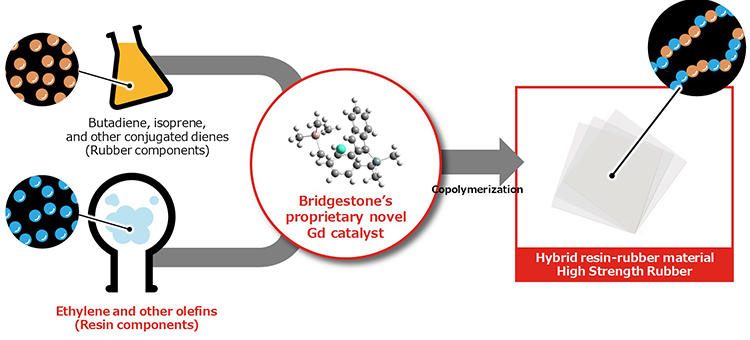Bridgestone Successfully Develops World’s First Polymer Using Advanced Synthetic Technology for Forming Hybrid Polymer
Creation of Next-Generation Material that Combines the Pliability of Rubber with the Toughness of Resin
Tokyo (May 17, 2018)—Bridgestone Corporation today announced that it has successfully developed the world’s first*1 polymer to bond rubber and resins at the molecular level. This new polymer boasts unprecedented durability with crack resistance that is over five times higher,*2 abrasion resistance that is more than 2.5 times higher,*3 and tensile strength that is more than 1.5 times higher*4 than natural rubber, which itself has higher destruction resistance than common synthetic rubber.
The newly developed polymer, called High Strength Rubber (HSR), is a hybrid material to bond synthetic rubber components such as butadiene and isoprene, with resin components such as ethylene,*5 at the molecular level by using Bridgestone’s proprietary novel gadolinium (Gd) catalyst*6 (via copolymerization*7). As a result, this next-generation material is able to combine the pliability of rubber with the toughness of resin. This breakthrough was achieved by further evolving the Gd catalyst technologies used to synthesize the polyisoprene rubber*8 announced in December 2016.

Newly Developed High Strength Rubber―World’s First Polymer of its Kind
HSR boasts levels of durability and abrasion resistance that eclipse those of natural rubber. For this reason, HSR is a promising next-generation tire material with the potential to create tires that achieve the required levels of performance while using less materials. Bridgestone therefore anticipate that HSR will be a powerful asset for the accomplishment of the goal of working towards 100% sustainable materials*9 set for 2050 in the Bridgestone Group's Long-term Environmental Vision. Bridgestone also intends to actively examine the possibility of utilizing HSR in products other than tires.
As the world’s largest tire and rubber company, Bridgestone will continue working to balance its operations with the earth’s capacity and contribute to the realization of a sustainable society as it strives to address the various needs of its customers.
*1. Source: Bridgestone Corporation
*2. The figure is based on tests using JIS K 6270 (a strain-controlled method for testing the tensile fatigue properties of vulcanized rubber and thermoplastic rubber).
*3. The figure is based on tests using JIS K 6264-2 (a revised Lambourn abrasion test for determining the abrasion resistance of vulcanized rubber and thermoplastic rubber).
*4. The figure is based on tests using JIS K 6251 (a test for determining the tensile properties of vulcanized rubber and thermoplastic rubber).
*5. Ethylene is a basic material used in creating plastic, synthetic fibers, and other petrochemicals. Polyethylene, which is created through polymerization of ethylene, is the most commonly used synthetic resin
*6. A gadolinium catalyst is a type of polymerization catalyst developed by Bridgestone that makes it possible to synthesize high-performance rubber.
*7. Copolymerization is a process of reacting two or more monomer molecules together in a chemical reaction to form polymer chains.
*8. For more information, please refer to "Bridgestone Succeeds in Creating Synthetic Isoprene Rubber through Precise Molecular Structure Control" (released on December 13, 2016.) https://www.bridgestone.com/corporate/news/2017022401.html
*9. The Bridgestone Group defines “sustainable materials” as materials that are derived from resources with a continual supply, can be used as part of our businesses over the long term, and have a low environmental and social impact throughout their whole lifecycle, from procurement to disposal.
About Bridgestone Corporation:
Bridgestone Corporation, headquartered in Tokyo, is the world’s largest tire and rubber company. In addition to tires for use in a wide variety of applications, it also manufactures a broad range of diversified products, which include industrial rubber and chemical products and sporting goods. Its products are sold in over 150 nations and territories around the world.